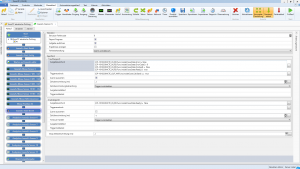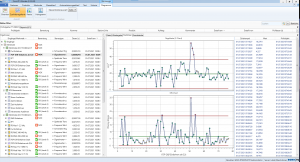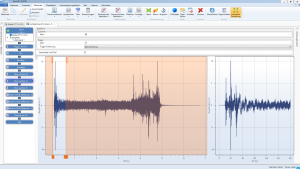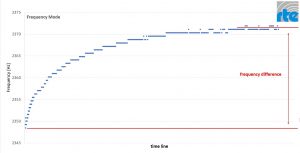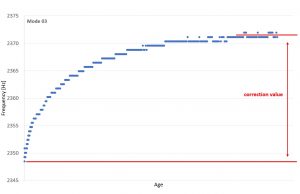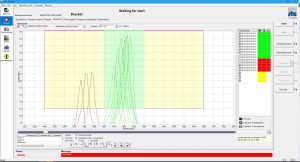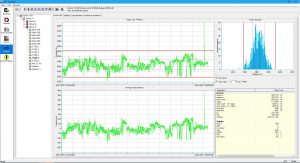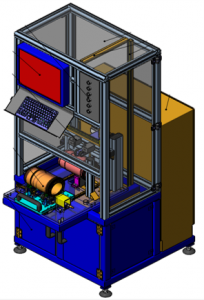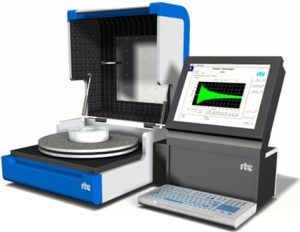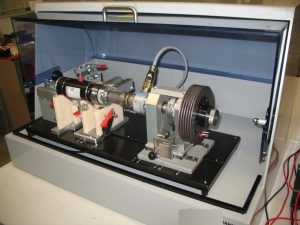Our Testing Systems
In addition to the testing software SonicTC, RTE also supplies complete testing systems and automated test facilities.
The SonicTC testing software can be used as a single license for applications in the laboratory, as a workstation license and for subsequent installation in test systems.
Test systems from RTE consist of the sensors for recording the measurement signals, the data acquisition modules and the test computer. RTE supplies these as an integration kit for installation in existing or new test systems. The connection to the system control can be easily implemented using all important communication protocols.
A perfect solution for machine engineering companies!
Complete test systems are developed, designed and manufactured in accordance with specifications and requirements books.
RTE also offers many standard test systems for various test applications, such as compact single-user testers for natural frequency measurements on brake discs or mobile devices for process monitoring.
Please contact us with your test task.

SonicTC. Software

NOISE AND VIBRATION TESTING
Testing Software SONICTC.NVH
Securing the product quality as well as noise testing is an important part of today’s manufacturing strategy. Test results have to be documented and will ensure the traceability. Post analysis will support a continuous process improvement.
Acoustic testing technology enables fast and objective product and component testing. Noise and vibration analysis are used to monitor operation and allows immediate conclusions to be drawn about the quality of the manufacturing process and the product. To do this, sounds transmitted through the air or the structure are recorded during operation, analysed and classified to give a pass/fail result.
SonicTC testing system is developed for noise and function testing in serial or mass production. Besides acoustic signals, any physical measurement parameters can be measured and evaluated (current, voltage, temperature etc.). Future-proof and sustainable software architecture as well as the intuitive workflow configuration are some of the key benefits of SonicTC. The testing system is designed to work with the present and future interface modules.
Industry 4.0 targets require manufacturing plants and testing systems to be able to exchange data and evaluate that shared data. In addition, the systems should be centrally monitored and controlled. The SonicTC testing system was specifically developed to meet these requirements. It has the capability to communicate with higher-level systems and can be easily integrated into manufacturing execution systems (MES).
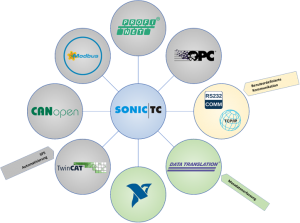
Use
- Future-proof software technology
- Customised data import and export
- Available for stand-alone to networking system
- Local testing and evaluation via control centre
- Accessibility / administration via test control centre
- Pre-configuration of server-client architecture
- Customised on-screen display
- Free testing sequence control
- Input variables: All physically measured variables (notably air-borne, body-borne noise, etc.)
- Huge variety of analysing methods and algorithms
- Graphical configuration
- Customising on-screen design
- Product traceability
- Automatic product/program change
- Data management option (SQL-server)
- Monitoring of parameters and characteristics
- Parallel testing applications
- Data storing local/server
- Separate databases (work flow, measurement results)
- Simultaneous operation of multiple test stations
- Traceability of test sequence changes
- Calibration
- User rights administration
- Multilingual
- Statistics application
- Re-evaluation/simulation
- Online monitoring function
- Client/Server
- Preconfigured process interfaces
SonicTC can implement the following processes:
- Freely-configurable bandpass filters
- High pass, low pass filters
- Band rejection filter
- Blanking
- Static positions
- Amplitude triggering
- FFT spectrum
- DFT spectrum
- Modulation spectrum (modulation analysis)
- Order analysis
- Cepstrum (real, complex)
The following methods are integrated:
- Maximum value
- Minimum value
- Average value
- RMS (Effective value, average squared)
- Crest factor
- Kurtosis
- Cumulative value
- Peak to peak value
- Peak counter
- Order analysis
- Klirr factor
- Ripple factor
- Option: time/distance correlation analysis
SonicTC implements the following frequency domain analysis methods:
- Sum level
- Min level, max level
- Mean level
- Limit curve spectrum
SonicTC implements the following psychoacoustic analysis methods:
- Volume
- Acuity
- Harshness
- Tilt
- Electric motors
- Pumps
- Transmissions
- Turbines
- Fans
- Actuators
- Rotors
- etc.
- Automotive
- Medical technology
- Domestic appliances
- Industrial engineering
- Aeronautics
- Mechanical engineering

SonicTC. Software

ACOUSTIC MATERIAL TESTING
Testing Software SONICTC.AT
Quality assurance and process optimisation requirements are steadily increasing. This has resulted in the growing importance of objective testing solutions.
Acoustic testing technologies in form of vibrations and sounds are now applied across all areas to test products in a non-destructive way. These technologies are primarily used for testing material strength, microstructures, connective quality, fissures and much more. Surface faults are not detectable.
Acoustic resonance analysis is based on the physical effect of a body (component) finding its resonant frequency (specific “oscillation”) after suitable vibrational stimulation. Resonant frequencies are determined by geometry and material properties. Acoustic material testing uses precisely this effect to detect changes to the component.
Acoustic material testing is a comparative process, which is why there is a need for previously classified components to determine, i.e. programme, the characterisation of good and faulty components within the testing system. Deviations are measured and monitored through a time signal or frequency spectrum.
Oscillations and vibrations can be captured using airborne or structure-borne sound.
SonicTC.AT was specifically developed to provide environmentally-friendly and non-destructive 100% testing of products based on the acoustic resonance analysis process (ring test). The reliable assessment of time signals, frequency ranges and vibrational modes is conducted by comparing them to pre-programmed good or bad patterns.
Thanks to its short testing and analysis time, acoustic testing technology is an excellent solution for monitoring components in a mass production setting. It’s also possible to combine this technology with other testing methods, and in some cases, it makes sense to do so. A statistical analysis of the test data also enables continuous process monitoring.
USE
- Flexible integration of the testing technology into automated manufacturing processes.
- Use of one system to test different types of products.
- Automated testing process with quality assessment in ca. 1 second.
- Compensation of adverse effects (variations in dimension, temperature, weight or age). This increases selectivity and enables the detection of smaller defects.
- Easy to operate with different user settings.
- System-based programming to recognise good and faulty parts.
- Extensive follow-up evaluation allows features to be added, changed or validated.
- Testing system for manufacturing and laboratory environments: The same system can be used in manufacturing and development. Test processes, inspection criteria and measurement archives are interchangeable.
- Testing structures, modularity or hardness
- Crack testing
- Material or identification testing
- Weight and dimensions monitoring
- Natural frequency measurement
- Monitoring fusion and coupling processes
- Components must generally be able to vibrate and oscillate sufficiently.
- The defaults that are monitored must have acoustic relevance and result in clear, interpretable changes.
- The manufacturing process should have good process stability (low tolerance).
- Feasibility studies on the testing application must be conducted beforehand.
Important: Detectable defect sizes depend on the process stability and the approved component tolerance.
- User guide (menu and image-assisted)
- Data collection and analysis, including additional process variables
- Flexible user management
- Q-Das data interface
- Compensation models (e.g. for temperature, weight, aging)
- Quality and attenuation measurement
- Statistics e.g. for process monitoring
- Language modules for user interface and online support
- Calibration
- Follow-up evaluation
- List of frequency levels
- Frequency position/frequency level/frequency attenuation
- Frequency band
- Frequency segmentation
- Frequency spacing and other calculation functions
- Multi-line recognition
- Pattern features
- Attenuation and quality features of vibrational modes (special RTE process)
- Temperature variations
- Weight fluctuations
- Variances in geometry
- Structural variations
- Age of structure

SonicTC. Software

ACOUSTIC PROCESS MONITORING
Testing Software SONICTC.DSP
Noise and vibrations are rapidly changing signals that describe the state of a process. In-line acquisition and evaluation can be used for:
- Early detection of defects when monitoring machine condition
- Monitoring of assembly processes, e.g. connector assembly, couplings, etc.
- Noise and vibration testing of manufacturing stations aided by fast signal analysis
- Fit monitoring
- Tool and machine wear
Acoustic process monitoring requires standardised devices and highly reliable programs that can be used in harsh industrial conditions. The SonicTC.DSP is a low-cost yet powerful and robust signal processing system for easy acoustic process monitoring.
SonicTC. Hardware
Testing Hardware
Specification, selection and provision of suitable test hardware is crucial for the successful implementation of testing tasks. RTE only uses hardware with the highest quality standards. The flexibility in the connectivity of our SonicTC testing software allows the use of all components and manufacturers available on the market.
Among other things, all common acoustic sensors can be used, such as structure-borne sound sensors, air-borne sound sensors (microphones) and laser vibrometers for non-contact vibration measurement, as well as ultrasonic sensors for particularly demanding testing tasks in the ultrasonic area.
A particular strength of SonicTC is that all other physical characteristics can also be measured and evaluated with the corresponding sensors (temperatures, electrical data, speeds, toque, Hall signal evaluation, etc.).
The data acquisition takes place via high-precision hardware and the SonicTC test software on reliable IPCs.
RTE offers complete integration kits for retrofitting or setting up new test systems.
The design variants range from simple laboratory solutions, manual test systems to completely automated test stands (EOL or in-line).
- Mobile test hardware (laboratory, studies, development)
- Manual test stands – offline (parallel to production or small series)
- Automatic test stands – inline or EOL (100% series monitoring)
Our experts will be happy to help and advise you. Contact us about your testing task today!
Acoustics is the study of sound and its propagation.
Sound is first and foremost a noise, a tone, a bang, as perceived by humans with their hearing.
- Structure-borne sound is oscillation or vibration that propagates in a solid body.
- Airborne sound is emitted from the solid.
With a laser vibrometer, vibrations can even be measured without contact.

